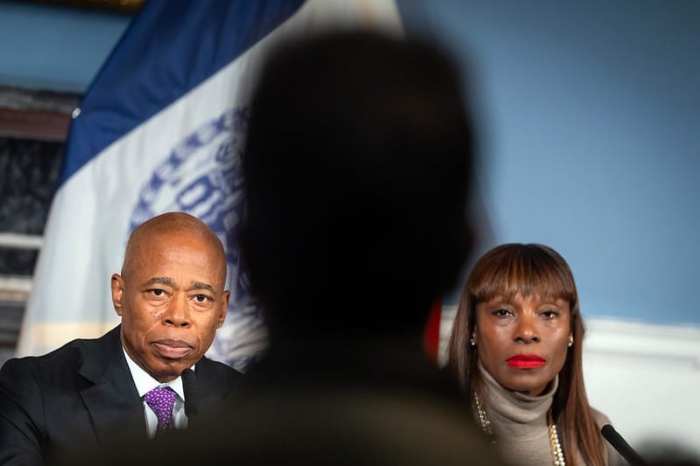As Queens gears up to celebrate the 350th anniversary of the Flushing Remonstrance, the earliest known petition for religious freedom, swastikas defaced an Orthodox Jewish house of worship on a quiet street in Hillcrest.
Within hours, they were wiped out and more than 50 elected officials and civic leaders of every race and belief, stood together to condemn the act of what authorities are calling “another copy-cat” act of vandalism.
Sometime after 6 a.m. on Thursday, October 18, neighbors discovered a swastika spray-painted on the bulletin board of Young Israel of Hillcrest, an orthodox Jewish schul located at 169-07 Jewel Avenue.
Minutes later, a second Nazi emblem was found sprayed on the passenger-side window of a Hatzolah volunteer ambulance which was parked in the driveway.
Both swastikas looked nearly identical, as if done by the same hand.
Rabbi Richard Weiss stood on the sidewalk, staring at the bed sheet which covered the defaced message board of the congregation he has headed for two years.
“I heard there was an incident like this about six years ago” he said, as crime scene investigators from the New York City Police Department (NYPD) carefully measured and photographed the scene around him. “But I’ve never seen anything like this around here until now.”
Shortly afterwards the sheet was removed, so that NYPD investigators could take paint samples. As passing automobiles slowed down to view the scene, some passengers appeared visibly shaken by the image.
Within hours, the glass on the message board had been cleaned; the ambulance was taken out of service and replaced with another.
By 5 p.m., a press conference, hastily called together by State Assemblymember Rory Lancman, brought expressions of solidarity from the outraged community, punctuated by expressions of anger and contempt.
Lancman, a member of the congregation, suggested that better security cameras would have given a clearer picture of the perpetrators. He expressed confidence that justice would prevail nevertheless.
Borough President Helen Marshall said, “I stand with my Jewish friends to say that these sorts of incidents have no place in a civilized society.”
State Senator Toby Stavisky reminded the gathering that Queens is the most diverse county in the country and that “Kristallnacht began with one broken window and one swastika.”
City Councilmember James F. Gennaro, who represents the district, summarized the outrage. Visibly agitated, Gennaro said, “I am a Catholic, but this is MY temple as well. I give whoever did this a message: Jews and Catholics, rich and poor, it doesn’t matter - we are looking for you. We will find you and we will bring you to justice.”
Gennaro has offered a $1,000 reward for information that “will lead to the apprehension of a hate monger.”
Kenneth Cohen, president of the northeast Queens branch of the National Association for the Advancement of Colored People recalled, “When our organization was founded here in 1906, our Jewish brothers and sisters were there. We are here for them now.”
There is no little irony surrounding the date. Exactly 62 years before, on October 18, 1945, the Nazi War Crimes trials began in Nuremburg, Germany.
Top city officials, including Police Commissioner Raymond Kelly, have characterized recent appearances of swastikas and hangman’s nooses as “copycat incidents” and the acts of school-age children who don’t appreciate the criminality of their actions.
Even Rabbi Weiss, in his quiet remarks at the press conference and earlier in the day, placed the incident in the context of youthful ignorance. “Kids do things without thinking,” Weiss said. “They need education to see how wrong they are.”
In the community, neighbors wrestle with their feelings.
Moishe Wargon, 55, has lived “down on the next block” from Young Israel for 25 years. Early in the day, before any microphones were set up, he typified the spectrum of emotions, especially a desire to not become like his tormentor.
“Maybe it’s because of Halloween and kids think it’s a prank to do this,” he said, shaking his head. “Shaving cream is a prank; this isn’t.”
“Maybe they don’t know any better, but this is maybe worse than a hangman’s noose to a black person.” Wargon said. Both of his parents are Holocaust survivors.
When asked what he would say to the perpetrators, Wargon glanced at his hands. “If I caught them in the act? Maybe I wouldn’t say; maybe I would do.”































